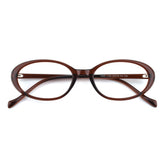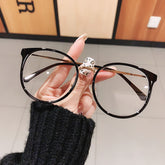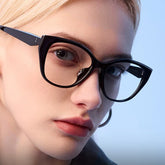Computer Glasses: Protect Your Eyes in the Digital Age
In our screen-dominated lives, digital eye strain has become a common issue. Whether you’re working, gaming, or binge-watching your favorite shows, prolonged screen exposure can lead to discomfort and long-term eye health concerns. Computer glasses, which are specially designed eyewear for digital device use, can protect your eyes in the digital age.
- What are computer glasses?
- Why do you need computer glasses?
- Do computer glasses really work?
- How are computer glasses different from regular glasses?
- How to choose the right pair?
What are computer glasses?
Computer glasses are specialized eyewear designed to reduce eye strain and filter harmful light from digital screens. Unlike regular glasses, they're optimized for the unique visual demands of computer use. They can reduce eye fatigue for more comfortable screen time, improve sleep quality by minimizing blue light exposure before bedtime, and enhance contrast and clarity, reducing squinting and strain.
Why do you need computer glasses?
Staring at screens for extended periods can cause Computer Vision Syndrome (CVS), with symptoms like:
- Eye fatigue and dryness
- Blurred vision
- Headaches
- Neck and shoulder strain
Computer glasses address these issues with features tailored for digital use:
- Blue light filtering: Computer glasses block or absorb a portion of harmful blue light emitted by digital screens, which may contribute to eye strain and sleep disruption.
- Anti-glare coating: Computer glasses can minimize reflections from screens and overhead lighting.
- Slight Magnification: Computer glasses help your eyes focus more comfortably at screen distance (unlike reading glasses, which are for closer print).
Do computer glasses really work?
The effectiveness of computer glasses depends on your specific needs and usage, but a 2021 Optometry and Vision Science study found blue light glasses reduced eye strain by 35% in office workers.
- Reduced Eye Strain: Clinical studies show they can decrease computer vision syndrome symptoms by 30-40%.
- Blue light protection: Computer glasses may help maintain circadian rhythms when used at night.
- Anti-Fatigue Benefits: The +0.50 to +0.75 diopter boost measurably reduces accommodative stress in 2+ hour screen sessions.
Quality computer glasses provide most regular computer users measurable comfort benefits. But please don't replace proper screen habits (the 20-20-20 rule remains essential). The benefits of the computer glasses diminish if you don't wear them consistently, so please continue to use them regularly.
- Every 20 minutes, look 20 feet away for 20 seconds.
- Adjust screen brightness to match your surroundings.
- Position your monitor at arm’s length, slightly below eye level.
- Wear computer glasses consistently during evening screen use.
How are computer glasses different from regular glasses?
Unlike standard prescription glasses or reading glasses primarily for vision correction, computer glasses are specially designed to reduce eye strain and discomfort caused by prolonged screen use. Here’s how they differ:
- Purpose: Computer glasses are optimized for digital screens to reduce blue light exposure, glare, and eye fatigue. Regular glasses correct refractive errors (myopia, hyperopia, and astigmatism) or presbyopia (reading glasses).
- Blue Light Filtering: Many computer glasses have a blue light filter coating to block or reduce high-energy visible blue light emitted by screens, which may improve sleep and reduce digital eye strain. Regular glasses typically don’t block blue light unless specifically requested.
- Anti-Reflective Coating: Computer glasses often include an anti-reflective coating to minimize glare from screens and overhead lighting. Regular glasses may or may not have AR coating (usually added for night-driving benefits).
- Lens Design: Single-vision computer glasses are set for a fixed intermediate distance (about 20-26 inches), ideal for screen use. Regular glasses have lenses tailored for distance, reading, or multifocal needs (like bifocals/progressives).
- Tint and Magnification: Some computer glasses have a slight yellow or amber tint to enhance contrast and reduce glare. Regular glasses are usually clear unless designed for sunglasses or specific conditions.
How to choose the right pair?
- Determine your needs: If you experience dry eyes, headaches, or blurred vision after screen use, blue light-blocking glasses or anti-reflective (AR) coated lenses may help. If you already wear glasses, consider computer-specific prescription lenses with an optimized focal distance for screens (usually 20-26 inches).
- Check lens quality: Polycarbonate lenses are lightweight and impact-resistant. High-index lenses are thinner and lighter for stronger prescriptions. Glass lenses are rarely used due to weight and fragility.
- Consider glasses comfort: Lightweight frames with comfortable nose pads prevent discomfort during long wear. Wide enough lenses cover your field of vision when looking at the screen.
- Try different coatings: Yellow/amber-tinted lenses block more blue light but can distort colors. Clear lenses with blue light coating offer protection without color distortion. Anti-reflective coating reduces glare from screens and overhead lighting.
Computer glasses are more than a trend—they’re a practical solution for digital eye strain. Whether you opt for non-prescription blue light blockers or custom prescription lenses, the right pair can enhance comfort and protect your vision.











